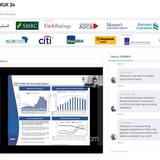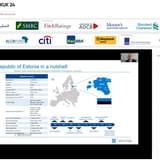An economic slowdown and political uncertainty are making potential investors nervous about committing long-term funding in Poland and raising doubts about the country’s ability to maintain economic growth while implementing a costly reform package.
As a result, PiS has been forced to back down on new monetary policy implemented in March and seemingly abandon plans for a Swiss franc mortgage re-denomination initiative – a key demand voiced during recent protests in Warsaw under the slogan: “Poland for citizens, not corporations and banks”.
“The market is edging towards easing rather than tightening”, says Roxanna Hulea, VP, EM strategy at Societe Generale. “The market believes that if more disappointment on the growth front follows, the government would look for further accommodation.”
Fear of potential currency destabilisation through an influx of speculative capital is one of the factors pushing policymakers to keep the interest rate at 1.5%, even as record levels of deflation persist. This cautious approach is likely to hold throughout much of the next year, until price growth, they hope, begins to approach the 2.5% target.
However, some observers note that these targets are largely based on a series of optimistic assumptions that may not materialise, adding an element of risk to current spending plans.
Record low unemployment and high consumer spending have been crucial for maintaining growth at a healthy 3.1%, but generous state initiatives like the planned child benefits programme and lowering of the official retirement age to 65 for men and 60 for women, while popular, may not be sustainable in the long run.
Some analysts link the Central Bank’s conservative stance to concerns about political turbulence rather than fear of risky capital flows. EU funding for public infrastructure projects has dried up, as investors grow increasingly concerned by the state interventions and a more heavy-handed approach. The recent dismissal of the Treasury Minister and the cabinet reshuffle that followed did little to instil confidence.
Confidence in the banking sector shaky
Similarly, an air of uncertainty surrounds the banking sector, which has undergone major changes over the last 12 months. The government has been exploring various opportunities to cover excessive spending and balance its books.
FI tax hikes appear to have had a limited effect as banks increasingly find shelter in non-taxable government bond holdings. As a result, only PLN3.5bn of tax is expected to be collected from the banks next year, a third of the figure for the current year. Because of fiscal underperformance, analysts expect the government to tweak fiscal measures further – for example, by taxing average incomes rather than end-of-the-month returns, similarly to the Hungarian model.
Meanwhile, the ongoing “Polonization” of the banking sector, which sees the state purchase stakes in foreign-owned banks, has so far yielded only limited success and may yet prove damaging in the long run, some analysts suspect. Last Wednesday, state-run Alior Bank and PKO BP confirmed they are in talks to buy Raiffeisen's banking and leasing arms, respectively. While the plan may allow homeowners, who borrowed in foreign currencies, to convert their debts, it will also force out foreign investors who currently own those assets and, potentially, scare away new money from entering the sector.
Furthermore, the PiS is stalling on its election vow to re-denominate the Swiss-franc mortgages. It now appears that the government may water down initially proposed measures, and is likely to choose a less heavy-handed approach that involves incentivising banks to convert the mortgages. Industry experts warn moves like re-denomination and loan-restructuring could lead to massive losses and further weaken the investment climate in the country in the long run.
For now, the fiscal targets for 2016-17 appear relatively safe. One off revenues from the National Bank of Poland, the selling of mobile licences, and delays in implementation of the costlier policies could help ease pressure on the budget.
There is more uncertainty surrounding the second half of 2017 and 2018, but for now, policymakers are set on keeping the budget deficit below 3%.
Poland’s rating was downgraded by S&Ps at the beginning of this year, and in August Moody’s warned of further damage to the rating if the country’s constitutional crisis and conflict with the EU is not resolved.
"It is not possible to achieve a higher economic growth rate without investment. But the political climate is not conducive to a rise in investment", says Grzegorz Maliszewski, chief economist at the Warsaw-based Bank Millennium.
It seems increasingly apparent that as the PiS continues to woo the public with strong government presence in the financial sector and high spending, it will be hard-pressed to achieve Poland’s fiscal and economic goals in the next few years. A more flexible and nuanced approach will be the key to success.









